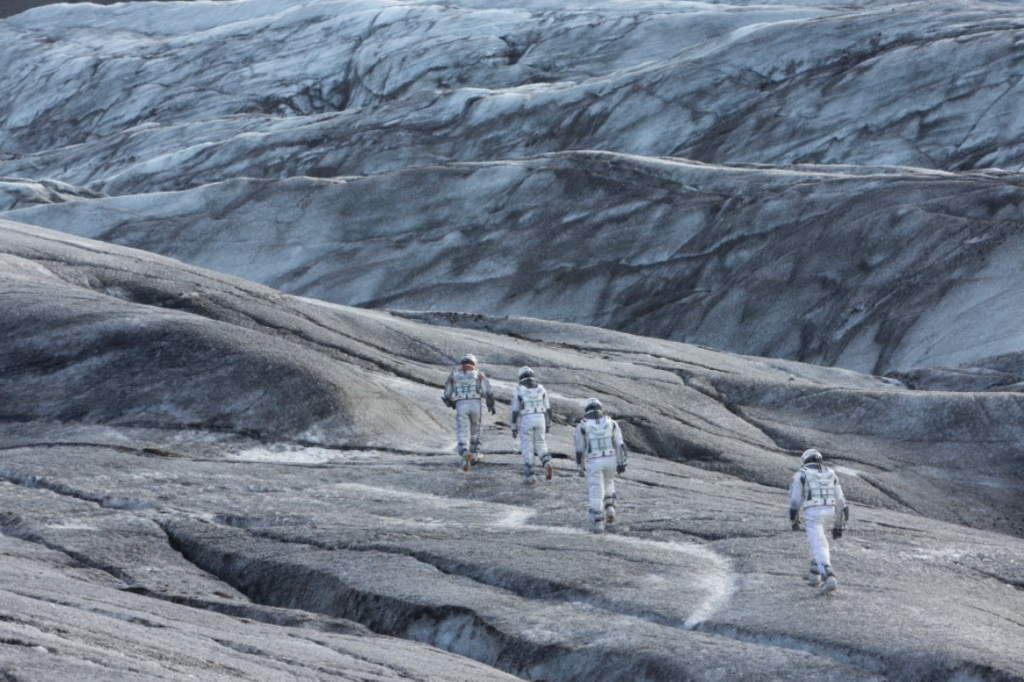Christopher Nolan’s Interstellar is a cinematic masterpiece that transcends the boundaries of traditional science fiction. At its core, the film is a profound meditation on humanity’s relationship with science, time, and the cosmos. Interstellar becomes a visual exploration of what it means to be human in an infinite universe. This year celebrates a decade of this film and this essay exploring the unknown, the depiction of space and also the relationship between science and love inside interstellar.
One of the most striking aspects of Interstellar is its commitment to scientific accuracy. The film’s depiction of black holes, wormholes, and time dilation is grounded in the work of renowned physicist Kip Thorne, who served as a scientific consultant. This dedication to realism elevates the film from mere science fiction to a speculative yet plausible vision of humanity’s future.
For instance, the rendering of the black hole Gargantua, with its accretion disk and gravitational lensing, is not just visually stunning but also scientifically credible. This attention to detail creates a sense of authenticity that allows the audience to fully immerse themselves in the narrative.
Time is not just a scientific concept in Interstellar; it is a central thematic element that drives the narrative and shapes the characters’ journeys. The film’s exploration of time dilation, where hours on a distant planet equate to years on Earth, creates a poignant tension between Cooper’s personal mission and the passage of time for those he left behind. This temporal distortion is not merely a plot device, it is a literary tool that underscores the fragility of human existence and the inevitability of loss.

Christopher Nolan’s Depiction of Space: A Balance of Realism and Fiction
Christopher Nolan’s Interstellar is a cinematic achievement that masterfully balances scientific realism with creative storytelling. By collaborating with physicist Kip Thorne, Nolan crafted a film that adheres to real astrophysical theories while also embracing elements of artistic liberty to enhance the narrative. There is interplay between scientific accuracy and fictional embellishments in Interstellar, particularly in its depiction of black holes, wormholes, and relativity.
One of the film’s most remarkable scientific portrayals is Gargantua, the supermassive black hole that serves as a pivotal point in the story. Unlike the usual portrayal of black holes in science fiction as dark, swirling voids, Interstellar‘s depiction is based on Einstein’s general theory of relativity. The film’s visual effects team, working closely with Thorne, simulated how light bends around a black hole, creating a luminous accretion disk that encircles Gargantua.
Another scientifically grounded concept in Interstellar is the use of a wormhole as a method of interstellar travel. The film represents it as a sphere rather than the typical “tunnel” seen in science fiction. This aligns with theoretical physics, where a wormhole acts as a bridge between two distant points in space-time. Though still hypothetical, Nolan ensures that this concept is depicted in a way that remains within the realm of scientific plausibility.
However, Interstellar does take certain creative liberties, particularly in its interpretation of the fifth-dimensional Tesseract scene. When Cooper falls into the black hole, he finds himself in a surreal, multidimensional construct that allows him to communicate with Murph across time. While visually stunning and thematically powerful, this aspect of the film ventures into speculative fiction, as our understanding of black holes does not currently support the idea of a traversable, structured dimension beyond space-time. Despite this, the scene serves as an emotional and narrative climax, demonstrating how Nolan seamlessly merges hard science with cinematic storytelling.
Ultimately, Interstellar succeeds in balancing realism and fiction, using scientific principles as a foundation while allowing room for creative interpretation. The film challenges audiences to contemplate the mysteries of the cosmos while ensuring that its artistic vision remains compelling and immersive.
Interstellar and the Sublime: Awe, Fear, and the Unknown
Interstellar is not just a film about space exploration, it is a meditation on the sublime. The overwhelming mixture of awe and fear in the face of the unknown. Christopher Nolan masterfully utilizes vast cosmic landscapes, Hans Zimmer’s evocative score, and the narrative’s existential themes to evoke an emotional and philosophical response in the audience.
Space, as portrayed in Interstellar, is both breathtaking and terrifying. The film captures the vast emptiness of the cosmos, emphasizing its beauty while simultaneously evoking a sense of isolation. Planets such as Miller’s world, covered in endless waves, or Mann’s icy wasteland, serve as reminders of nature’s indifference to human survival. The use of IMAX cinematography further amplifies this feeling. This interplay of scale and perspective aligns with the concept of the sublime, where nature is not just vast but also beyond human comprehension.
Hans Zimmer’s score plays a crucial role in enhancing the film’s sense of awe and fear. Moments of silence in the vacuum of space are just as impactful, reinforcing the idea that the universe is not designed for human existence. This stark contrast between sound and silence mirrors the emotional heights and lows of the characters, drawing the audience deeper into the film’s existential themes.
At its core, Interstellar is about humanity’s struggle against the unknown. The characters face not only the vastness of space but also the limitations of their own mortality. Cooper’s journey is fueled by hope and love, yet he is constantly reminded of time’s relentless march forward. The time dilation sequence on Miller’s planet, where every hour equals seven years on Earth, is one of the most powerful examples of how Interstellar turns scientific theory into an emotional gut punch.

Real-World Space Exploration: A Mirror to Humanity’s Aspirations
Interstellar is not just a work of fiction, it is a reflection of humanity’s real-world aspirations to explore the cosmos. The film’s depiction of a dying Earth, driven by environmental collapse, serves as a cautionary tale about the consequences of neglecting our planet. At the same time, it offers a hopeful vision of space exploration as a means of survival and renewal.
From a literary perspective, the film’s connection to real-world space exploration underscores its thematic focus on hope and perseverance. The character of Dr. Brand, who advocates for the continuation of human life through space travel, embodies the spirit of exploration that has driven humanity for centuries. Her famous line, “We’re not meant to save the world, we’re meant to leave it,” encapsulates the film’s central tension between preservation and progress.
Furthermore, the film’s portrayal of the Lazarus missions and the search for a new home for humanity echoes the real-world challenges of interstellar travel. The vast distances, the limitations of technology, and the psychological toll of isolation are all themes that resonate with contemporary discussions about the feasibility of colonizing other planets. By grounding its narrative in these real-world concerns, Interstellar becomes a poignant commentary on the human condition and our enduring desire to reach for the stars.
From a literary perspective, the film’s scientific rigor serves as a metaphor for humanity’s relentless pursuit of knowledge. Just as Cooper and his team venture into the unknown to save humanity, scientists in the real world push the boundaries of understanding to unravel the mysteries of the universe. The film’s portrayal of space travel as both awe-inspiring and perilous mirrors the dual nature of scientific exploration: it is a journey filled with wonder, but also one fraught with uncertainty and risk. In this way, Interstellar becomes a celebration of human curiosity and ingenuity, themes that resonate deeply with the literary tradition of exploring humanity’s place in the cosmos.
Love as a Scientific and Literary Force in Interstellar
Interstellar is a film that seamlessly weaves together themes of science and emotion, with love emerging as one of its most profound and controversial motifs. Dr. Brand’s assertion that “love is the one thing we’re capable of perceiving that transcends time and space” suggests that love is not merely an emotion but a fundamental force akin to gravity. Love in Interstellar operates as both a narrative and metaphysical force, drawing upon romantic and transcendental themes found in literature.
The film’s treatment of love resonates with literary traditions that view love as an eternal and guiding force. In classical literature, love often defies logic and mortality, much like Cooper’s unwavering connection to Murph. Dante Alighieri’s Divine Comedy, for example, portrays love as the force that moves the universe. Beatrice, though physically absent, serves as Dante’s guiding light, much as Murph becomes Cooper’s beacon across time and space. Similarly, in Shakespearean tragedies, love frequently bends reality, as seen in Romeo and Juliet, where love transcends death itself. Interstellar modernizes these literary ideals, embedding them within a scientifically driven narrative.
Moreover, the film’s exploration of love aligns with transcendentalist thought, particularly on the interconnectedness of all things. This mirrors how Dr. Brand believes love to be more than mere biochemical reactions, something that persists beyond life, logic, and physical barriers. The film suggests that, like gravity, love has an unseen but undeniable influence on the universe.
The climax of Interstellar, where Cooper navigates the Tesseract and communicates with Murph, symbolizes love’s power to bridge dimensions. Although the setting is deeply rooted in theoretical physics, its emotional core is a father’s love defying the boundaries of time. This moment encapsulates the film’s literary depth, blending scientific curiosity with poetic transcendence.
Interstellar’s portrayal of love is not just a speculative concept but one deeply rooted in literary tradition. By intertwining love with space-time, Nolan reimagines age-old themes of devotion, destiny, and transcendence in a futuristic framework. Whether seen as scientific or poetic, Interstellar posits that love, like gravity, is a force that binds us to each other and the universe itself.








